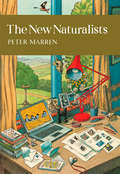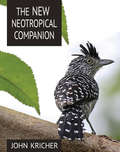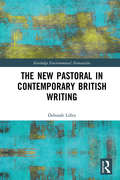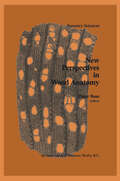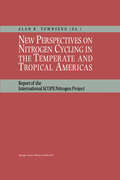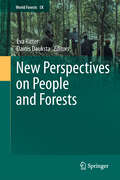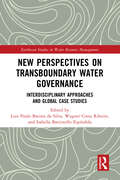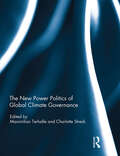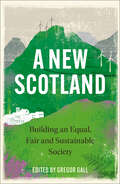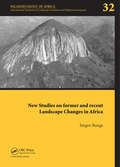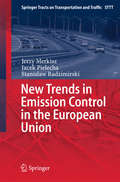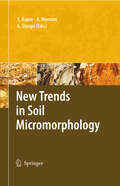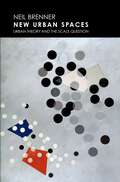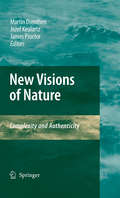- Table View
- List View
The New Naturalists: A Complete History (Collins New Naturalist Library #82)
by Peter MarrenA history of the most successful, significant and long-running natural history series in the world.
The New Neotropical Companion
by John KricherThe acclaimed guide to the ecology and natural history of the American tropics—now fully updated and expandedThe New Neotropical Companion is the completely revised and expanded edition of a book that has helped thousands of people to understand the complex ecology and natural history of the most species-rich area on Earth, the American tropics. Featuring stunning color photos throughout, it is a sweeping and cutting-edge account of tropical ecology that includes not only tropical rain forests but also other ecosystems such as cloud forests, rivers, savannas, and mountains. This is the only guide to the American tropics that is all-inclusive, encompassing the entire region's ecology and the amazing relationships among species rather than focusing just on species identification.The New Neotropical Companion is a book unlike any other. Here, you will learn how to recognize distinctive ecological patterns of rain forests and other habitats and to interpret how these remarkable ecosystems function—everything is explained in clear and engaging prose free of jargon. You will also be introduced to the region's astonishing plant and animal life.Informative and entertaining, The New Neotropical Companion is a pleasurable escape for armchair naturalists, and visitors to the American tropics will want to refer to this book before, during, and after their trip.Covers all of tropical AmericaDescribes the species and habitats most likely to be observed by visitorsIncludes every major ecosystem, from lowland rain forests to the high AndesFeatures a wealth of color photos of habitats, plants, and animals
The New Neotropical Companion
by John KricherThe acclaimed guide to the ecology and natural history of the American tropics—now fully updated and expandedThe New Neotropical Companion is the completely revised and expanded edition of a book that has helped thousands of people to understand the complex ecology and natural history of the most species-rich area on Earth, the American tropics. Featuring stunning color photos throughout, it is a sweeping and cutting-edge account of tropical ecology that includes not only tropical rain forests but also other ecosystems such as cloud forests, rivers, savannas, and mountains. This is the only guide to the American tropics that is all-inclusive, encompassing the entire region's ecology and the amazing relationships among species rather than focusing just on species identification.The New Neotropical Companion is a book unlike any other. Here, you will learn how to recognize distinctive ecological patterns of rain forests and other habitats and to interpret how these remarkable ecosystems function—everything is explained in clear and engaging prose free of jargon. You will also be introduced to the region's astonishing plant and animal life.Informative and entertaining, The New Neotropical Companion is a pleasurable escape for armchair naturalists, and visitors to the American tropics will want to refer to this book before, during, and after their trip.Covers all of tropical AmericaDescribes the species and habitats most likely to be observed by visitorsIncludes every major ecosystem, from lowland rain forests to the high AndesFeatures a wealth of color photos of habitats, plants, and animals
The New Noah
by Gerald DurrellIf you want to know how to capture, and then make friends with an ant-eater, an electric eel, or a porcupine or a boa-constrictor, this is your book. When Gerald Durrell goes wild-animal hunting he takes interest and affection along with his nets and traps. And his captives enjoy luxury treatment as he discovers how to feed and train them and prepare them for display in the zoos to which they are destined. This is a fascinating book, for the reader is let into many secrets of the animal hunter’s trade, as well as being introduced to a variety of charming and curious animals such as capybaras, hoatzins, and tucotucos, not to mention a tame curassow called Cuthbert.
The New Pastoral in Contemporary British Writing (Routledge Environmental Humanities)
by Deborah LilleyThis book identifies a major turn in contemporary British literature in response to environmental crisis. It argues that the pastoral is emerging as a new critical framework in which to explore the understanding of people and place in this context. The New Pastoral in Contemporary British Writing explores how the pastoral tradition has transformed as authors respond to our changing relationships with place in this period. Analysing the features common to new pastoral writing, it brings together a corpus of works from major authors including Ali Smith, Jim Crace, John Burnside, Kathleen Jamie, and Robert Macfarlane. This book argues that crises such as pollution and climate change have shifted our understandings of the key relationships of pastoral and the terms upon which they are based, giving new senses to its older oppositions between the human and the natural, the urban and the rural, and the past and the present. Furthermore, it shows that the versions of pastoral that ensue align with current ecocritical arguments produced by thinking through the individual, cultural, and ecological implications of environmental crisis. As a result, pastoral emerges as the crucial strategy in the re-imagining of the environment underway in contemporary British writing, the resurgence of interest in nature writing, the increasing attention towards place in literary fiction, and the development of ecological or ‘climate’ fiction. This book will be of great interest to students and scholars of English as well as those concerned with the interdisciplinary topics of the environmental humanities, including literary geographies, new nature writing, cultures of climate change and the Anthropocene, and ecologically-oriented theory.
The New Pastoral in Contemporary British Writing (Routledge Environmental Humanities)
by Deborah LilleyThis book identifies a major turn in contemporary British literature in response to environmental crisis. It argues that the pastoral is emerging as a new critical framework in which to explore the understanding of people and place in this context. The New Pastoral in Contemporary British Writing explores how the pastoral tradition has transformed as authors respond to our changing relationships with place in this period. Analysing the features common to new pastoral writing, it brings together a corpus of works from major authors including Ali Smith, Jim Crace, John Burnside, Kathleen Jamie, and Robert Macfarlane. This book argues that crises such as pollution and climate change have shifted our understandings of the key relationships of pastoral and the terms upon which they are based, giving new senses to its older oppositions between the human and the natural, the urban and the rural, and the past and the present. Furthermore, it shows that the versions of pastoral that ensue align with current ecocritical arguments produced by thinking through the individual, cultural, and ecological implications of environmental crisis. As a result, pastoral emerges as the crucial strategy in the re-imagining of the environment underway in contemporary British writing, the resurgence of interest in nature writing, the increasing attention towards place in literary fiction, and the development of ecological or ‘climate’ fiction. This book will be of great interest to students and scholars of English as well as those concerned with the interdisciplinary topics of the environmental humanities, including literary geographies, new nature writing, cultures of climate change and the Anthropocene, and ecologically-oriented theory.
New Perspectives in Wood Anatomy: Published on the Occasion of the 50th Anniversary of the International Association of Wood Anatomists (Forestry Sciences #1)
by P. BaasOn the occasion of the 50th Anniversary of the International Association of Wood Anatomists several symposia were held during the 13th International Botanical Congress in Sydney, August 1981. Extended versions of most of the invited papers presented there, and some additional papers on aspects which could not be included in the congress program constitute the contents of this book, which intentionally received the pretentious title 'New Perspectives in Wood Anatomy'. To some readers it may seem a paradox that under this heading papers on a diversity of partly traditional wood anatomical subjects are assembled, even including two with a historical emphasis. However, a study of the history of wood anatomy and of how students of that discipline joined forces in an inter national association, brings to light many facts and views which deserve the attention of present day and future wood scientists as a potential source of in spiration for their research and organisational work.
New Perspectives on Nitrogen Cycling in the Temperate and Tropical Americas: Report of the International SCOPE Nitrogen Project
by Alan R. TownsendInputs of nitrogen to terrestrial and aquatic ecosystems have increased several-fold over the last one hundred and fifty years, with the steepest increases during the last four decades. The expansion of fertilizer manu facture and use, the increase in fossil fuel combustion, the intensification of animal husbandry, and widespread cultivation of N2 fixing crops have all contributed to the dramatic increase in N inputs. The increase has been most rapid in Northern Hemisphere (NH) temperate ecosystems, but presently subtropical and tropical regions of Asia are also experiencing an explosive increase in N inputs to terrestrial ecosystems (W. Chameides, pers. comm. ; Galloway et al. 1996). Projected increases in N deposition for these trop ical and subtropical regions, with a high natural background of N inputs, exceed increases projected for temperate and arctic regions (Cleveland et al. submitted; Galloway et al. 1994; Holland & Lamarque 1997a). Compared to biological N fixation, N deposition is becoming a proportionately greater source of N to terrestrial and aquatic ecosystems worldwide (Vitousek et al. 1997). 6 The nitrogen contained in the atmosphere as N , 3. 9 * 10 Tg (Tg = 2 12 10 g), is the largest reservoir of N in the Earth system (Warneck 1988). However, this paper focuses on the nitrogen emissions and deposition that have been transformed from N2 into reactive forms that are biologically avail able (e. g. Vitousek et al. 1997).
New Perspectives on People and Forests (World Forests #9)
by Eva Ritter and Dainis DaukstaThe aim of this book is to elucidate the role of forests as part of a landscape in the life of people. Most landscapes today are cultural landscapes that are influenced by human activity and that in turn have a profound effect on our understanding of and identification with a place. The book proposes that a better understanding of the bond between people and forests as integrated part of a landscape may be helpful in landscape planning, and may contribute to the discussion of changes in forest cover which has been motivated by land use changes, rural development and the global climate debate. To this end, people’s perception of forest landscapes, the reasons for different perceptions, and future perspectives are discussed. Given the wide range of forest landscapes, and cultural perspectives which exist across the world, the book focuses on Europe as a test case to explore the various relationships between society, culture, forests and landscapes. It looks at historical evidence of the impacts of people on forests and vice versa, explores the current factors affecting people’s physical and emotional comfort in forest landscapes, and looks ahead to how changes in forest cover may alter the present relationships of people to forests. Drawing together a diverse literature and combining the expertise of natural and social scientists, this book will form a valuable reference for students and researchers working in the fields of landscape ecology and landscape architecture, geography, social science, environmental psychology or environmental history. It will also be of interest to researchers, government agencies and practitioners with an interest in issues such as sustainable forest management, sustainable tourism, reserve management, urban planning and environmental interpretation.
New Perspectives on Transboundary Water Governance: Interdisciplinary Approaches and Global Case Studies (Earthscan Studies in Water Resource Management)
by da Silva, Luis Paulo Batista Wagner Costa Ribeiro Isabela Battistello EspíndolaThis book presents a novel examination of transboundary water governance, drawing on global case studies and applying new theoretical approaches. Excessive consumption and degradation of natural resources can either heighten the risks of conflicts or encourage cooperation within and among countries, and this is particularly pertinent to the governance of water. This book fills a lacuna by providing an interdisciplinary examination of transboundary water governance, presenting a range of novel and emerging theoretical approaches. Acknowledging that issues vary across different regions, the book provides a global view from South and Central America, Africa, Asia, and the Middle East, with the case studies offering civil society and public managers concrete situations that indicate difficulties and successes in water sharing between bordering countries. The volume highlights the links between natural resources, political geography, international politics, and development, with chapters delving into the role of paradiplomacy, the challenges of climate change adaptation, and the interconnections between aquifers and international development. With rising demand for water in the face of climate change, this book aims to stimulate further theoretical, conceptual, and methodological debate in the field of transboundary water governance to ensure peaceful and fair access to shared water resources. This book will be of interest to students and scholars of water resource governance from a wide variety of disciplines, including geography, international relations, global development, and law. It will also be of interest to professionals and policymakers working on natural resource governance and international cooperation.
New Perspectives on Transboundary Water Governance: Interdisciplinary Approaches and Global Case Studies (Earthscan Studies in Water Resource Management)
This book presents a novel examination of transboundary water governance, drawing on global case studies and applying new theoretical approaches. Excessive consumption and degradation of natural resources can either heighten the risks of conflicts or encourage cooperation within and among countries, and this is particularly pertinent to the governance of water. This book fills a lacuna by providing an interdisciplinary examination of transboundary water governance, presenting a range of novel and emerging theoretical approaches. Acknowledging that issues vary across different regions, the book provides a global view from South and Central America, Africa, Asia, and the Middle East, with the case studies offering civil society and public managers concrete situations that indicate difficulties and successes in water sharing between bordering countries. The volume highlights the links between natural resources, political geography, international politics, and development, with chapters delving into the role of paradiplomacy, the challenges of climate change adaptation, and the interconnections between aquifers and international development. With rising demand for water in the face of climate change, this book aims to stimulate further theoretical, conceptual, and methodological debate in the field of transboundary water governance to ensure peaceful and fair access to shared water resources. This book will be of interest to students and scholars of water resource governance from a wide variety of disciplines, including geography, international relations, global development, and law. It will also be of interest to professionals and policymakers working on natural resource governance and international cooperation.
The New Power Politics of Global Climate Governance
by Maximilian Terhalle Charlotte StreckThis book is based on the assumption that great powers determine global politics and, in this instance, environmental politics. It addresses the approaches of both established and rising powers and their implications for the advancement of international climate negotiations. The new introduction looks at the key developments in this realm since 2013, examining the bilateral deals between China and the United States and the results of the UNFCCC’s 21st Convention of the Parties (COP) convening at Paris in 2015. Two key features link the contributions of this volume: their underlying assumption that major powers are the central actors in determining global environmental politics; and their assessment of, and implications of, the approaches both of rising and established major powers for global climate norms. One key argument of this volume is that today’s geopolitics are about who gets how much in the fiercely competitive race over the available ‘carbon space’. The book concludes that prudently balancing power in the new century requires a fair sharing of burden among the existing and emerging powers. In light of such burden-sharing, pluralistic domestic politics as well as diverging normative beliefs and worldviews require consideration of different conditions, even if historical legacies of the industrialised world have increasingly been put into question as a political argument by the United States.This book is based on a special issue of the journal Climate Policy.
The New Power Politics of Global Climate Governance
by Maximilian Terhalle Charlotte StreckThis book is based on the assumption that great powers determine global politics and, in this instance, environmental politics. It addresses the approaches of both established and rising powers and their implications for the advancement of international climate negotiations. The new introduction looks at the key developments in this realm since 2013, examining the bilateral deals between China and the United States and the results of the UNFCCC’s 21st Convention of the Parties (COP) convening at Paris in 2015. Two key features link the contributions of this volume: their underlying assumption that major powers are the central actors in determining global environmental politics; and their assessment of, and implications of, the approaches both of rising and established major powers for global climate norms. One key argument of this volume is that today’s geopolitics are about who gets how much in the fiercely competitive race over the available ‘carbon space’. The book concludes that prudently balancing power in the new century requires a fair sharing of burden among the existing and emerging powers. In light of such burden-sharing, pluralistic domestic politics as well as diverging normative beliefs and worldviews require consideration of different conditions, even if historical legacies of the industrialised world have increasingly been put into question as a political argument by the United States.This book is based on a special issue of the journal Climate Policy.
A New Scotland: Building an Equal, Fair and Sustainable Society
by Gregor GallInequality and unfairness still stalk Scotland after more than twenty years of devolution. Having done little to shield against austerity, Brexit and an increasingly right-wing Westminster agenda, calls for further constitutional reform to solve pressing political, economic and social problems grow ever louder. The debate over further devolution or independence continues to split the population. In A New Scotland, leading activists and academics lay out the blueprints for radical reform, showing how society can be transformed by embedding values of democracy, social justice and environmental sustainability into a coherent set of policy ideas. Structured in two parts, the book takes to task the challenges to affect radical change, before exploring new approaches to key questions such as healthcare, education, public ownership, race, gender and human rights.
A New Scotland: Building an Equal, Fair and Sustainable Society
Inequality and unfairness still stalk Scotland after more than twenty years of devolution. Having done little to shield against austerity, Brexit and an increasingly right-wing Westminster agenda, calls for further constitutional reform to solve pressing political, economic and social problems grow ever louder. The debate over further devolution or independence continues to split the population. In A New Scotland, leading activists and academics lay out the blueprints for radical reform, showing how society can be transformed by embedding values of democracy, social justice and environmental sustainability into a coherent set of policy ideas. Structured in two parts, the book takes to task the challenges to affect radical change, before exploring new approaches to key questions such as healthcare, education, public ownership, race, gender and human rights.
New Studies on Former and Recent Landscape Changes in Africa: Palaeoecology of Africa 32
by Jörgen RungeVolume 32 (2013) of the internationally recognized and acclaimed yearbook seriesPalaeoecology of Africa publishes 9 new interdisciplinary scientific papers on former and recent landscape evolution and on past environments of the African continent (e.g. climate change, vegetation dynamics and growing impact of humans on ecosystems). These papers
New Trends in Emission Control in the European Union (Springer Tracts on Transportation and Traffic #4)
by Jerzy Merkisz Jacek Pielecha Stanisław RadzimirskiThis book discusses recent changes in the European legislation for exhaust emissions from motor vehicles. It starts with a comprehensive explanation of both the structure and range of applicability of new regulations, such as Euro 5 and Euro 6 for light-duty vehicles and Euro VI for heavy-duty vehicles. Then it introduces the most important issues in in-service conformity and conformity of production for vehicles, describing the latest procedures for performing exhaust emissions tests under both bench and operating conditions. Subsequently, it reports on portable emission measurement systems (PEMS) and their application for assessing the emissions of gaseous and particulate matter alike, under actual operating conditions and in all transport modes. Lastly, the book presents selected findings from exhaust emissions research on engines for a variety of transport vehicles, such as light-duty and heavy-duty vehicles, as well as non-road vehicles, which include farm tractors, groundwork and forest machinery, diesel locomotives, high-rail vehicles, combat vehicles and special-purpose vehicles. This work offers a valuable reference guide for researchers and professionals dealing with environmental regulations and vehicle manufacturing in the European Union.
New Trends in Soil Micromorphology
by Selim Kapur Georges StoopsThe soil water retention curve, the saturated hydraulic conductivity and the unsaturated hydraulic conductivity function are basic soil hydraulic functions and parameters. Ample apprehension of the soil hydraulic functions and parameters is required for a successful formulation of the principles leading to sustainable soil management, agricultural production and environmental protection. From these, all the other parameters, required in the solution of the practical tasks, are derived. The basic soil hydraulic functions are strongly dependent upon the soil porous system. The development of models is characteristic by the gradual transition from the simplest concepts up to the sophisticated approaches, which should correspond to the visual reality studied by soil micromorphology. 2 Soil Porous System and Soil Micromorphometry 2.1 An Overview on the Quantification of the Soil Porous System Quanti? cation of the soil porous system consists of classi? cation of soil pores, ch- acterization of the soil pores shapes and the estimation of the pore size distribution function. When the hydraulic functions of the soil pores are considered, the following laws of hydrostatics and hydrodynamics are applied as best ? tting to the classi? cation criteria of the size of the pores (Kutilek and Nielsen 1994, p. 20, Kutilek 2004): A. Submicroscopic pores that are so small that they preclude clusters of water molecules from forming ? uid particles or continuous water ? ow paths.
New Urban Spaces: Urban Theory and the Scale Question
by Neil BrennerThe urban condition is today being radically transformed. Urban restructuring is accelerating, new urban spaces are being consolidated, and new forms of urbanization are crystallizing. In New Urban Spaces, Neil Brenner argues that understanding these mutations of urban life requires not only concrete research, but new theories of urbanization. To this end, Brenner proposes an approach that breaks with inherited conceptions of the urban as a bounded settlement unit-the city or the metropolis-and explores the multiscalar constitution and periodic rescaling of the capitalist urban fabric. Drawing on critical geopolitical economy and spatialized approaches to state theory, Brenner offers a paradigmatic account of how rescaling processes are transforming inherited formations of urban space and their variegated consequences for emergent patterns and pathways of urbanization. The book also advances an understanding of critical urban theory as radically revisable: key urban concepts must be continually reinvented in relation to the relentlessly mutating worlds of urbanization they aspire to illuminate.
NEW URBAN SPACES C: Urban Theory and the Scale Question
by Neil BrennerThe urban condition is today being radically transformed. Urban restructuring is accelerating, new urban spaces are being consolidated, and new forms of urbanization are crystallizing. In New Urban Spaces, Neil Brenner argues that understanding these mutations of urban life requires not only concrete research, but new theories of urbanization. To this end, Brenner proposes an approach that breaks with inherited conceptions of the urban as a bounded settlement unit-the city or the metropolis-and explores the multiscalar constitution and periodic rescaling of the capitalist urban fabric. Drawing on critical geopolitical economy and spatialized approaches to state theory, Brenner offers a paradigmatic account of how rescaling processes are transforming inherited formations of urban space and their variegated consequences for emergent patterns and pathways of urbanization. The book also advances an understanding of critical urban theory as radically revisable: key urban concepts must be continually reinvented in relation to the relentlessly mutating worlds of urbanization they aspire to illuminate.
New Visions of Nature: Complexity and Authenticity
by Martin A. M. Drenthen F.W. Jozef Keulartz James Proctor"New Visions of Nature" focuses on the emergence of these new visions of complex nature in three domains. The first selection of essays reflects public visions of nature, that is, nature as it is experienced, encountered, and instrumentalized by diverse publics. The second selection zooms in on micro nature and explores the world of contemporary genomics. The final section returns to the macro world and discusses the ethics of place in present-day landscape philosophy and environmental ethics. The contributions to this volume explore perceptual and conceptual boundaries between the human and the natural, or between an ‘out there’ and ‘in here.’ They attempt to specify how nature has been publicly and genomically constructed, known and described through metaphors and re-envisioned in terms of landscape and place. By parsing out and rendering explicit these divergent views, the volume asks for a re-thinking of our relationship with nature.
New Vistas in Agroforestry: A Compendium for 1st World Congress of Agroforestry, 2004 (Advances in Agroforestry #1)
by P. K. Ramachandran Nair M. R. Rao L. E. BuckIt was in late 2002 that the idea of preparing a collection of multi-authored chapters on different aspects of ag- st forestry as a compendium for the 1 World Congress of Agroforestry, June 2004, was tossed around. With the approval of the idea by the Congress Organizing Committee, serious efforts to make it a reality got under way in early 2003. The rigorously peer-reviewed and edited manuscripts were submitted to the publisher in December 2003. Considering the many differentindividualsinvolved in the task as authors and manuscriptreviewers, we feel quite pleased that the task could be accomplished within this timeframe. We are pleased also about the contents on several counts. First of all, the tropical-temperate mix of topics is a rare feature of a publication of this nature. In spite of the scienti?c commonalities between tropical and temperate practices of agroforestry, the differences between them are so enormous that it is often impossible to mesh them together in one publication. Secondly, several of the chapters are on topics that have not been discussed or described much in agroforestryliterature. A third feature is that some of the authors, though well known in their own disciplinary areas, are somewhat new to agroforestry; the perceptions and outlooks of these scholars who are relatively unin?uenced by the past happenings in agroforestry gives a whole new dimension to agroforestry and broadensthescopeofthesubject. Finally, ratherthanjustreviewingandsummarizingpastwork,mostchapterstake the extra effort in attempting to outline the next steps.
New Welsh Review 135: Threshold (New Welsh Review)
by Pippa Marland Satterday Shaw Philippa HollowayBringing together the best of Wales' review-essays, including a comparison of new editions of nature classics, 'Back to the Land' by Pippa Marland. The books under review, Thomas Firbank's I Bought a Mountain and Margiad Evans' Autobiography take contrasting blustering and humble approaches to stepping over the sub/urban doorstep into nature. A showcase of new nonfiction, previewing forthcoming titles from some of Wales' key English-language publishers, exploring books on anti-Welsh media vitriol covering the early Manic Street Preachers, and historical flooding and the riches of an Eton-owned Benedictine fishery on the Gwent Levels. In original fiction: a wonderful story about a teenage boy on the cusp of bodily and emotional change, 'Trout', by Satterday Shaw, and a second, finely crafted story about the effect of geographical dislocation on teenage identity emergence, 'Another Place' by Philippa Holloway, set on Crosby beach. Plus Editorial by Gwen Davies and a new opinion feature, Last Page, by Richard Lewis Davies, in which the writers note that magazines in Wales are undergoing a transition, during which readers and subscribers will need to step up to the plate if a commitment to expressing – without interference - our particular place and time, is to be maintained. EDITORIAL Half-in, half-out Gwen Davies NONFICTION Bears at the Fridge: From Goldcliff to Whitson Preview extract from This Stolen Land by Marsha O'Mahony The Kinnock Factor: The Manics and Anti-Welshness Edited abridged preview from International Velvet by Neil Collins FICTION Another Place Story by Philippa Holloway Trout Story by Satterday Shaw ESSAYS Dark Formula Timothy Laurence Marsh on why reckless travel writing matters Books for Alien Girls JL George's personal and practical reflections on the role neurodivergence can and should play when writing fiction REVIEW-ESSAYS Back to the Land Pippa Marland on two nature memoir classics, one of hubristic bluster, the other humbly receptive 'Queer Old Codgers' Claire Pickard on the portrayal of highly nuanced gay identities and history in recent nonfiction titles and a major short story anthology THE LAST PAGE Back to the Future Richard Lewis Davies on how a culture with ambition needs critics and readers
A New World-System: From Chaos to Sustainability (Routledge Studies in Sustainable Development)
by Donald G. ReidA New World-System: From Chaos to Sustainability examines the present crisis in the social and ecological environment that is producing profound, potentially catastrophic challenges to the planet and humanity and outlines a process for moving forward to address these critical issues. This book is a cautionary interpretation of the present and vision for the future. Unlike other books on this or allied subjects that are focused singularly, Part 1 surveys the five major threats facing humanity today: climate change, inequality and poverty, new technologies, migration, and globalization. It approaches the challenge of integrating these phenomena into a global picture from a systems perspective rather than taking a purely reductionist approach to understanding what is occurring in the world today. Part 2 moves from identifying the problems to solving them, with chapters examining the ability of the present world-system to address these issues and outlining a process for action. The book concludes by discussing what could follow capitalism as a social organizing strategy and, perhaps more importantly, the consequences to the planet if we do not construct a new world-system. This book is essential reading for students and scholars of sustainable development, climate change, environmental studies, rural and urban planning, environmental psychology, political economy, sociology, social policy, leisure studies, and environmental politics. More broadly, it is a vital resource for all those interested in building a sustainable society.
A New World-System: From Chaos to Sustainability (Routledge Studies in Sustainable Development)
by Donald G. ReidA New World-System: From Chaos to Sustainability examines the present crisis in the social and ecological environment that is producing profound, potentially catastrophic challenges to the planet and humanity and outlines a process for moving forward to address these critical issues. This book is a cautionary interpretation of the present and vision for the future. Unlike other books on this or allied subjects that are focused singularly, Part 1 surveys the five major threats facing humanity today: climate change, inequality and poverty, new technologies, migration, and globalization. It approaches the challenge of integrating these phenomena into a global picture from a systems perspective rather than taking a purely reductionist approach to understanding what is occurring in the world today. Part 2 moves from identifying the problems to solving them, with chapters examining the ability of the present world-system to address these issues and outlining a process for action. The book concludes by discussing what could follow capitalism as a social organizing strategy and, perhaps more importantly, the consequences to the planet if we do not construct a new world-system. This book is essential reading for students and scholars of sustainable development, climate change, environmental studies, rural and urban planning, environmental psychology, political economy, sociology, social policy, leisure studies, and environmental politics. More broadly, it is a vital resource for all those interested in building a sustainable society.
